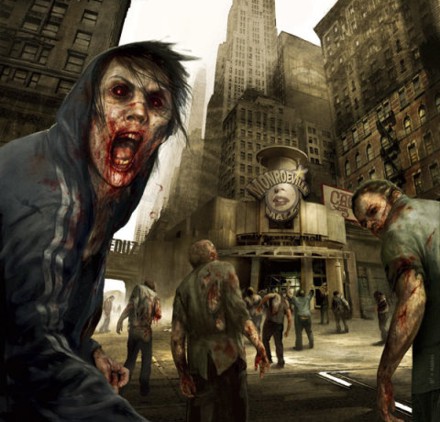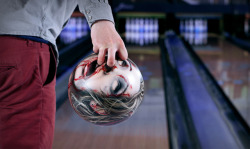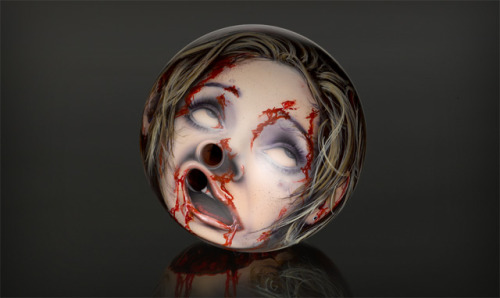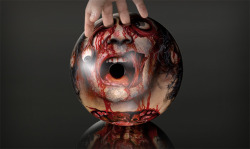Tag Archives: horror
Bath salt zombies scare cadets straight in Navy-produced video
The Navy has a new weapon in its arsenal against designer drug abuse: the mini-movie Bath Salts: It’s Not a Fad, It’s a Nightmare.
Available to the public on YouTube (and at the bottom of this page), the 6:37 minute movie uses horror-movie style special effects to simulate the hallucinogenic and often violent effects of the drug.
Shot from a young sailor’s point of view, the first 2 minutes of the video put the viewer behind the eyes of a cadet as he smacks his girlfriend in a bowling alley, witnesses his roommate morph into a horrific demon, and ultimately ends up convulsing on a hospital bed as he is held down by camouflage-wearing doctors.
According to Lieutenant George Loeffler, Chief Psychiatry Resident at the Naval Medical Center in San Diego, treatment centers within the armed forces are seeing more cases of bath salt abuse every month. In early 2012, the Navy announced an “alarming increase” in designer drug use, which led to 1515 sailors being discharged in 2011 alone according to the Navy-run Jet Observer.
Mr. Loeffler explained that paranoid delusions and psychotic episodes that last long after the drug is out of their systems. “When people are using bath salts, they’re not their normal selves. They’re angrier, they’re erratic, they’re violent, they’re unpredictable.”
“People will start acting really weird, seeing things that aren’t there, believing things that aren’t true,” Loeffler continued. “Some people describe people spying on them, trying to kill them and their families, other people talk about seeing demons, and things that are trying to kill them.”
The designer drug has the potential to cause permanent damage. “One of the most concerning things about bath salts is that these hallucinations, these paranoid delusions, will last long after the intoxication’s gone,” Loeffler says.
Similar to the designer drug spice—the synthetic version of marijuana until recently sold over the counter in tobacco shops—bath salts contain unknown ingredients which vary widely depending on the source. This makes experimenting with the drug essentially a game of Russian roulette, often with devastating effects.
Reports of a 31-year-old man named Rudy Eugene attacking a 65-year old homeless man in Miami, stripping off the victim’s clothes, and proceeding to eat his face recently brought national attention to the potential dangers involved with bath salts.
It later turned out that Mr. Eugene was not in fact using the synthetic drug, though the psychotic episodes and paranoid delusions experienced by the assailant are consistent with known side effects.
The military treats soldiers who test positive for drug use with a strict “zero tolerance”, and are increasingly able to detect many designer drugs. Many of the most dangerous chemicals, however, do not register on drug tests, according to Mr. Loeffler. This fact has been used specifically to market the drug to sailors, soldiers, and marines.
Are the Navy’s methods to discourage bath salt use excessively dramatic in their recent video, or appropriate to counter an increasingly threatening epidemic of designer drug abuse?
Decide for yourself after watching the video:
HALLOWEEN HORROR NIGHTS – THE WALKING DEAD
There is strength in numbers and you must band together to make it through many of the iconic settings made famous by the critically-acclaimed AMC hit, The Walking Dead. As the city is crawling with hordes of “walkers,” the issue of your becoming one of them is not a question of if, but when.
ZOMBIE HISTORY – The Plague That Is Zombies
 ‘I hereby resolve to kill every vampire in America” writes the young Abraham Lincoln in the best-selling 2010 novel “Abraham Lincoln: Vampire Hunter.” Honest Abe doesn’t quite make good on his promise, and the grim results are all around us. Today, vampires spring from the shadows of our popular culture with deadening regularity, from the Anne Rice novels to the Twilight juggernaut to this year’s film adaptation about the ghoul-slaying Great Emancipator. Lately we’ve also endured a decadelong bout with the vampire’s undead cousin, the zombie, who has stalked films from “28 Days Later” to “Resident Evil” (the next sequel of which is due out this fall) and the popular TV show “The Walking Dead.”
‘I hereby resolve to kill every vampire in America” writes the young Abraham Lincoln in the best-selling 2010 novel “Abraham Lincoln: Vampire Hunter.” Honest Abe doesn’t quite make good on his promise, and the grim results are all around us. Today, vampires spring from the shadows of our popular culture with deadening regularity, from the Anne Rice novels to the Twilight juggernaut to this year’s film adaptation about the ghoul-slaying Great Emancipator. Lately we’ve also endured a decadelong bout with the vampire’s undead cousin, the zombie, who has stalked films from “28 Days Later” to “Resident Evil” (the next sequel of which is due out this fall) and the popular TV show “The Walking Dead.”
Purists will hold forth on the differences between vampire and zombie, but the family resemblance is unmistakable. Both are human forms seized by an animal aggression, which manifests itself in an insatiable desire to feed on the flesh of innocents. (Blood, brains, whatever; it’s a matter of taste.) Moreover, that very act of biting, in most contemporary versions of both myths, transforms the victims into undead ghouls themselves.
Our vampires and zombies (as well as such poor relations as werewolves) all serve as carriers for vaguely similar saliva-borne infections. These mythical contagions are especially odd because they have so few analogues in the natural world. Indeed, there is really only one: the rabies virus.
A fatal infection of the brain, rabies is particularly devastating to the limbic system, one of the most primitive parts of the brain. Fear, anger and desire are hijacked by the virus, which meanwhile replicates prolifically in the salivary glands. The infected host, deprived of any sense of caution, is driven to furious attack and sometimes also racked with intense sexual urges. Today we know that most new diseases come from our contact with animal populations, but with rabies this transition is visible, visceral, horrible. A maddened creature bites a human, and some time later, the human is seized with the same animal madness.
Known and feared for all of human history—references to it survive from Sumerian times—rabies has served for nearly as long as a literary metaphor. For the Greeks, the medical term for rabies (lyssa) also described an extreme sort of murderous hate, an insensate, animal rage that seizes Hector in “The Iliad” and, in Euripides’ tragedy of Heracles, goads the hero to slay his own family. The Oxford English Dictionary documents how the word “rabid” found similar purchase in English during the 17th century, as a term of illness but also as a wrenching state of agitation: “rabid with anguish” (1621), “rabid Griefe” (1646).
The roots of the vampire myth stretch back nearly as far. Tales of vampire-like creatures, formerly dead humans who return to suck the blood of the living, date to at least the Greeks, before rumors of their profusion in Eastern Europe drifted westward to capture the popular imagination during the 1700s.
In its original imagining, though, the premodern vampire differed from today’s in one crucial respect: His condition wasn’t contagious. Vampires were the dead, returned to life; they could kill and did so with abandon. But their nocturnal depredations seldom served to create more of themselves.
All that changed in mid-19th century England—at the very moment when contagion was first becoming understood and when public alarm about rabies was at its historical apex. Despite the fact that Britons were far more likely to die from murder (let alone cholera) than from rabies, tales of fatal cases filled the newspapers during the 1830s. This, too, was when the lurid sexual dimension of rabies infection came to the fore, as medical reports began to stress the hypersexual behavior of some end-stage rabies patients. Dubious veterinary thinkers spread a theory that dogs could acquire rabies spontaneously as a result of forced celibacy.
Thus did rabies embody the two dark themes—fatal disease and carnal abandon—that underlay the burgeoning tradition of English horror tales. Britain’s first popular vampire story was published in 1819 by John Polidori, formerly Lord Byron’s personal physician. The sensation it caused was due largely to the fact that its vampire, a self-involved, aristocratic Lothario, distinctly resembled the author’s erstwhile employer.
But Polidori’s Byronic ghoul only seduced and killed. It took until 1845, with the appearance of James Malcolm Rymer’s serialized horror story “Varney the Vampire,” for the vampire’s bite to become a properly rabid act of infection. For the first time readers were invited to linger on the vampire’s teeth, which protrude “like those of some wild animal, hideously, glaringly white, and fang-like.” And at the long tale’s end, Varney’s final victim (a girl named Clara) is herself transformed into a vampire and has to be destroyed in her grave with a stake.
Both these innovations carried over into the most important vampire tale of all, Bram Stoker’s “Dracula.” In Stoker’s hands, the vampire becomes a contagious, animalistic creature, and his condition is properly rabid. It is a lunge too far to claim (as one Spanish doctor has done in a published medical paper) that the vampire myth derived literally from rabies patients, misunderstood to be the walking dead. But it is clear that this central act of undead fiction—the bite, the infection, the transferred urge to bite again—has rabies knit into its DNA.
Over time, the vampire’s contagion infected his undead cousin, too. The original zombie myth, as it derived from Haitian lore, also involved the dead brought back to kill, but again without contagion—an absence that carried over to Hollywood’s earliest zombie flicks. In this and many other regards, the most influential zombie tale of the 20th century was nominally a vampire tale: Richard Matheson’s 1954 novel “I Am Legend,” whose marauding hordes of contagious “vampires,” victims of an apocalyptic infection, set the whole template for what we now think of as the standard zombie onslaught.
Since then, as Hollywood has felt the need to conjure ever more frightening cinematic menaces, the zombie has if anything grown increasingly rabid. The antagonists in Matheson’s novel can, at times, carry on an intelligent conversation with a normal human. By the 2007 film adaptation, starring Will Smith, the infected are howling, lunging, senselessly hateful animals inside a human form. Danny Boyle, the director of “28 Days Later,” has said outright that he modeled his zombie virus on rabies. But even if he hadn’t consciously done so, the name he gave that virus—”Rage”—already draws its power from the same centuries-old supply.
Westerners don’t have much cause to fear death from rabies these days. Thanks to the availability of vaccine, human fatalities in the U.S. have dropped to a handful per year; Britain got rid of the virus entirely in 1902, succeeding in just the sort of national eradication project that apparently stymied the vampire-slaying Abraham Lincoln. Yet the infected bite, the human turned animal aggressor, menaces us as often as ever on our flat screens and nightstands.
Rabies itself may be a distant concern, but the rabid idea, like Varney the vampire, still has teeth—and it still succeeds in spreading itself.
When Zombies invite themself at Bowling- COOLEST THING FOR THE Z-POC
magine play bowling with the head of a zombie as a ball… When Zombies invite themselves at Bowling, a superb campaign for the German version of horror chanel 13th Street, which once again takes up the theme of zombie for its communication (like this previous campaign: Zombies on 13th St
Just when you thought nothing could make bowling any cooler, here come the zombies.





